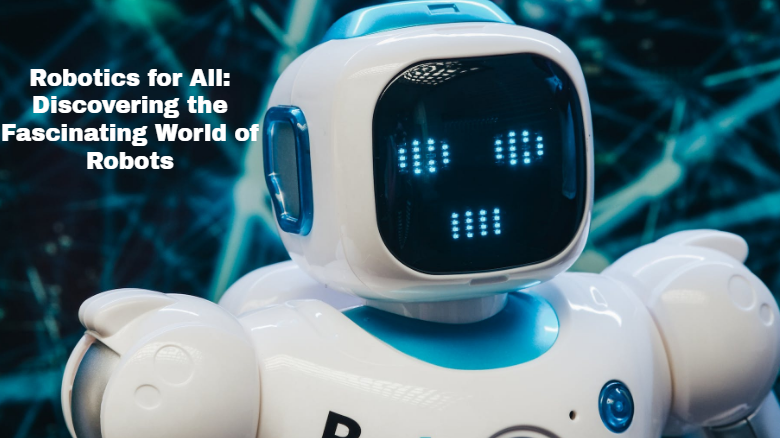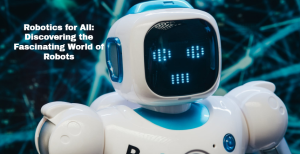Robotics for All: Discovering the Fascinating World of Robots
Robotics for All: Discovering the Fascinating World of Robots

Robotics for All: Discovering the Fascinating World of Robots
Robotics has evolved from science fiction fantasies to a technological reality that impacts various aspects of our lives. These mechanical marvels have become an integral part of industries healthcare education and even our homes. Let dive into the fascinating world of robots exploring their types components applications and the potential they hold for the future.
1. Introduction to Robotics
Robots are intelligent machines designed to chip chick technology and gadgets for women perform tasks autonomously or semiautonomously. They can be programmed to carry out a wide range of functions from manufacturing goods in factories to assisting with complex surgeries in hospitals.
Definition of Robotics
Robotics is the field of study that involves the design construction operation and application of robots. It combines principles from engineering computer science and artificial intelligence to create machines that can mimic human actions.
Historical Background of Robotics
The concept of robots has been present in human imagination for centuries. The term “robot” was coined by Czech playwright Karel Čapek in his 1920 play “R.U.R.” (Rossum Universal Robots). However the real progress in robotics started in the 20th century with the invention of the first industrial robot by George Devol in the 1950s.
2. Types of Robots
Robots can be categorized based on their application and functionality. Here are some common types:
Industrial Robots
Industrial robots are used in manufacturing and assembly lines to perform repetitive tasks with precision and speed. They have revolutionized industries by increasing productivity and reducing human labor in hazardous environments.
Service Robots
Service robots are designed to interact with humans and assist them with various tasks. They can be found in healthcare facilities hospitality and even households as smart assistants like Amazon Alexa or Google Home.
Educational Robots
Educational robots are used to teach programming problemsolving and engineering concepts to students of all ages. They come in various forms from basic coding toys to advanced robotics kits used in schools and workshops.
Medical Robots
Medical robots play a crucial role in surgeries providing enhanced precision and minimally invasive procedures. They can also aid in rehabilitation and assist patients with disabilities.
Domestic Robots
Domestic robots are designed to perform household chores and tasks such as vacuuming mopping and lawn mowing. They are becoming increasingly popular for their convenience and timesaving capabilities.
3. The Components of a Robot
Every robot comprises several essential components that enable its functionality:
Sensors
Sensors are the eyes and ears of a robot. They provide information about the robot surroundings allowing it to perceive and respond to its environment. Common sensors include cameras ultrasonic sensors and infrared sensors.
Actuators
Actuators are responsible for the robot movements. They convert electrical signals into physical motion. Motors and servos are common types of actuators used in robots.
Power Source
Robots require a reliable power source to function. This can be a battery an electric power supply or a combination of both depending on the robot design and application.
Controller
The controller serves as the brain of the robot. It processes data from sensors executes algorithms and controls the actuators to carry out specific tasks.
4. The Advancements in Robotics
The field of robotics has seen significant advancements in recent years pushing the boundaries of what robots can achieve. Some key areas of progress include:
Artificial Intelligence in Robotics
Artificial Intelligence (AI) plays a vital role in modern robotics. AI algorithms enable robots to learn from their experiences adapt to changing environments and make intelligent decisions.
Machine Learning in Robotics
Machine learning algorithms enable robots to improve their performance over time through continuous learning and data analysis. This has led to more efficient and capable robots.
HumanRobot Interaction
Advancements in humanrobot interaction have made it easier for humans to communicate with robots. Natural language processing and gesture recognition have enhanced the way we interact with these machines.
Swarm Robotics
Swarm robotics involves the coordination of multiple robots to work together towards a common goal. This approach takes inspiration from the collective behavior of social insects and has promising applications in search and rescue missions environmental monitoring and more.
5. Applications of Robotics
The versatility of robots has resulted in their widespread use across various fields. Some notable applications include:
Manufacturing and Automation
Robots have transformed the manufacturing industry by automating production lines and increasing efficiency. They can work continuously without fatigue and produce consistent results.
Healthcare and Surgery
In the medical field robots assist surgeons in performing complex procedures with greater precision. Robotic systems have reduced the invasiveness of surgeries and improved patient outcomes.
Space Exploration
Robots have been instrumental in space exploration missions where they can perform tasks in harsh and remote environments. Rovers like NASA Mars rovers have provided valuable data about distant planets.
Education and Research
Robots are valuable tools for education and research. They provide handson learning experiences and are used in scientific research to explore hazardous environments or collect data.
Entertainment and Gaming
Robots have made their way into entertainment and gaming industries. From robotic toys to interactive exhibits in theme parks they offer engaging experiences to the audience.
6. The Impact of Robotics on Society
The widespread adoption of robots has had both positive and negative impacts on society.
Job Automation and Employment
As robots take over repetitive and dangerous tasks there are concerns about potential job displacement for humans. However robots also create new job opportunities in industries related to robotics and AI.
Ethical Considerations
With advancements in AI questions arise about the ethical use of robots. Issues like robot rights privacy and accountability are becoming crucial topics of discussion.
Robotics and Disabilities
Robots have the potential to assist people with disabilities enhancing their independence and quality of life. Robotic prosthetics and exoskeletons are examples of how robots are positively impacting the lives of individuals with disabilities.
7. Robotics for Education and Learning
The field of robotics has great potential in education and learning environments.
Robotics in Schools
Many educational institutions are incorporating robotics into their curricula to teach programming problemsolving and teamwork skills. Robotics competitions like FIRST Robotics are popular among students.
Online Robotics Courses
Online platforms offer robotics courses accessible to learners worldwide. These courses cater to individuals with varying levels of experience and provide handson learning opportunities.
DIY Robotics Kits
DIY robotics kits allow enthusiasts of all ages to build and program their robots. These kits offer an excellent way to learn about robotics through practical experience.
8. Building Your First Robot
If you’re eager to get handson experience with robotics building your first robot can be a rewarding endeavor.
Choosing the Right Platform
Select a robot kit or platform that aligns with your interests and skill level. Consider factors like complexity programming language and the type of tasks the robot can perform.
Assembling the Robot
Follow the instructions provided with the kit to assemble the robot. This stepbystep process will help you understand the components and their functions.
Programming the Robot
Learn the basics of programming and apply them to make your robot move sense its environment and perform various actions. Experiment with different algorithms and functionalities.
9. Challenges in Robotics
Despite the significant progress in robotics several challenges still need to be addressed.
Technical Challenges
Creating robots that can adapt to unpredictable environments navigate complex terrains and perform delicate tasks remains a technical challenge.
Safety Concerns
As robots become more prevalent in human spaces ensuring their safety and preventing accidents are crucial concerns.
Legal and Regulatory Issues
The rise of autonomous robots raises legal questions about liability and responsibility in case of accidents or errors caused by robots.
10. Future Trends in Robotics
The future of robotics holds exciting possibilities with several emerging trends.
Collaborative Robots (Cobots)
Collaborative robots or cobots work alongside humans assisting them in tasks. They can provide increased productivity and safety in various industries.
Swarm Robotics
Swarm robotics inspired by the collective behavior of social insects enables groups of robots to collaborate effectively and perform complex tasks.
Bioinspired Robotics
Bioinspired robotics seeks to replicate biological systems resulting in robots with improved agility and adaptability.
Soft Robotics
Soft robotics involves designing robots with soft flexible materials making them safer for human interaction and capable of performing delicate tasks.
Conclusion
The world of robotics is a fascinating number information 1-800-837-4966 realm that continues to evolve transforming industries healthcare education and entertainment. With advancements in AI machine learning and humanrobot interaction the potential for robots in various applications is boundless. However as we embrace this technology it is essential to address ethical concerns and ensure that robotics benefits all of society.










